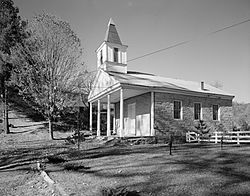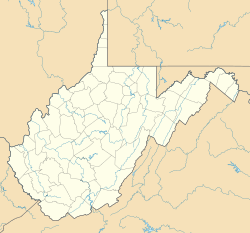Salt Sulphur Springs, West Virginia facts for kids
Quick facts for kids
Salt Sulphur Springs, West Virginia
|
|
|---|---|

Episcopal chapel in Salt Sulphur Springs
|
|
| Country | United States |
| State | West Virginia |
| County | Monroe |
| Elevation | 1,801 ft (549 m) |
| Time zone | UTC-5 (Eastern (EST)) |
| • Summer (DST) | UTC-4 (EDT) |
| Area code(s) | 304 & 681 |
| GNIS feature ID | 1546308 |
Salt Sulphur Springs is a small, quiet place in Monroe County, West Virginia. It's called an unincorporated community. This means it's a group of homes and businesses that don't have their own local government like a city or town. Instead, the county government helps manage things. You can find Salt Sulphur Springs along U.S. Route 219, a bit southwest of a town called Union.
Discovering Salt Sulphur Springs
Salt Sulphur Springs was once a very popular place. It started out as a special kind of vacation spot called a resort spa. People would visit to relax and try out the natural water.
The Healing Springs
The area is known for its two unique mineral springs. These springs have water that comes from underground. The water picks up minerals as it travels. People believed these minerals had special healing powers. They thought bathing in or drinking the water could help them feel better. This made Salt Sulphur Springs a famous place for health and wellness.
A Place in History
Many years later, in 1985, Salt Sulphur Springs was recognized for its important history. Several old buildings and other structures in the community were added to the National Register of Historic Places. This is a special list kept by the United States government. It includes places that are important to the history of the country.
When a group of buildings is listed together, it's called a historic district. The area in Salt Sulphur Springs is known as the "Salt Sulphur Springs Historic District." This means that seven buildings and two other structures were considered very important. They are called "contributing properties" because they help tell the story of the district's past. Protecting these places helps us learn about how people lived long ago.



